After The First World War
From 1915 until the early 1920s a series of massacres and deportations resulted in the destruction of almost the entire Armenian population within Turkish controlled territory. An estimated 1½ million Armenians perished at the hands of the Turkish and Kurdish perpetrators of this genocide.
To this day the Turkish State disputes that anything which could be classified as "genocide" actually took place. An important part of this denial has taken the form of minimising or removing evidence of the long Armenian presence in what is now eastern Turkey. If the victims never existed then how could they be killed, and if (a few) were killed then why should it matter if they, as a people, were of no cultural significance? With this aim, official Turkish history has been rewritten to eliminate the importance of Armenia and invent or exaggerate Turkish influences, population statistics have been falsified, and most place names of Armenian origin have been changed to Turkish ones. None of this encourages the preservation of Armenian buildings, the most obvious reminder and legacy of a past that Turkey wishes to entirely eliminate. Cultural Genocide
After the killing or removal by other means of a region's original population, the destruction of that population's cultural monuments invariably follows. The most recent example of this process occured in Kossovo.
"A people which is cut off from its own past is far less free to choose and to act as a people than one which has been able to situate itself in history. This is why - and this is the only reason why - the entire art of the past has now become a political issue"
In the years following the Armenian Genocide hundreds of Armenian churches in Turkey were deliberately destroyed because of their Armenian origin, a policy which continued at least into the 1970s. Hundreds, probably thousands, more have been allowed to fall into ruin, or to be plundered for building material, or to be demolished for redevelopment. The majority of these buildings had never been properly studied or even photographed. Since the 1930s there has been a conspiracy of silence amongst western archaeologists and art historians regarding Armenian sites in Turkey: they seem to turn unaccountably blind, deaf, and dumb whenever the word "Armenia" is mentioned. Even Armenian academics have participated in the cover-up. ¹
Today within Turkey, surviving Armenian buildings (especially those important for tourism) are often presented as being of Turkish or Byzantine origin, or they are presented as isolated examples that are unconnected to any larger Armenian culture, or the Armenian identities of the builders are disguised by calling them "Bagratid" or "Artzrouni" (the names of medieval Armenian princely families).
Some destruction did take place. Most of what seems to have been destroyed were the visible results of Nikolai Marr's excavations, including most of his repairs and restorations. Certain structures that would have been seen as having symbolic importance to Armenians may also have been destroyed at this time (such as the tomb of King Ashot at Horomos, and the khatchkar monument of Catholicos Barsegh).
Many Armenian monuments in the vicinity of Ani have been destroyed since 1920. The dates of their destruction are not exactly known. See the pages on the Khtzkonk and Bagnayr monasteries, the Tekor basilica, and Magazberd for examples.
Even though the 1921 order for the total demolition of Ani was not carried out, the history of Ani since the 1920s has been one of continuous and increasing destruction. The reasons for this can be placed into several categories:
The surviving half of the church of the Redeemer has now reached a state of imminent collapse, as have the southwest corner of the Cathedral, the surviving parts of the narthex of the church of Tigran Honents, and the hall of the church of the Apostles.
|
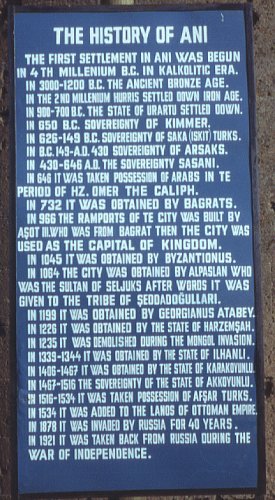 1. This information for tourists is placed at the entrance to Ani. The "history" that it tells is mostly fantasy, and Armenia is not even mentioned once!
1. This information for tourists is placed at the entrance to Ani. The "history" that it tells is mostly fantasy, and Armenia is not even mentioned once!
|
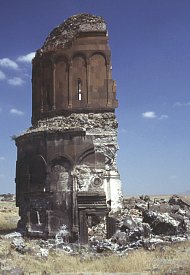 6. Half of the church of the Redeemer collapsed in 1955 during a storm |
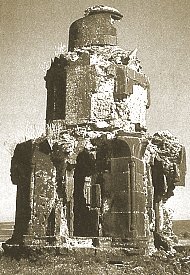 7. The church of the Shepherd - destroyed in the 1966 earthquake |
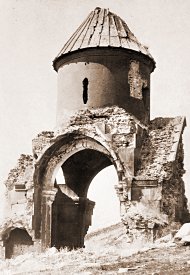 8. One of the citadel churches - destroyed in the 1966 earthquake |
|
Digging amongst the ruins by local villagers hunting for treasure used to be common. Fortunately, the damage caused by this activity was mostly small in scale - an exception being the 1998 breaking open of the graves in the burial chapels next to the church of Saint Gregory of the Abughamir's.
Visitors to Ani, both Turkish and foreign, seem to think that there is nothing wrong in writing their names onto the walls of the churches. The church of Tigran Honents, because of its frescoes, has been particularly susceptible to this sort of damage. Since the removal of travel restrictions to Ani in 2004, many Turkish visitors now come to Ani to picnic amongst the ruins. In total ignorance about how to behave at an archaeological site, they start fires, leave lots of rubbish behind, and use the churches as urinals. Visitors from Armenia are almost as ignorant - as proof, one need only note the number of empty bottles of "Noy" mineral water from Armenia that now litter the site. Officially Sanctioned DamageBecause the cathedral is the most prominent Armenian building in Ani it was the most likely candidate to suffer from state censorship. The interior walls of the cathedral are covered with crudely applied daubs of modern white paint. This paint has been put there to hide Armenian inscriptions. In other locations the paint has been carefully applied in blocks and has been chosen to blend in with the colour of the stone. The application of this paint occured not later than 1983. Probably, many of the inscriptions dated from after the fall of Ani and they have been hidden to remove the visible evidence of a continuing Armenian population in the Kars region, especially during the Russian period.When the amount of tourist graffiti covering the frescoes inside the Tigran Honents church became too great, the supposed custodians of Ani simply covered over the damaged parts with white paint. The frescoes on the northern wall of this church were particularly badly damaged by graffiti (including a large CND symbol carved into the plaster). To 'tidy' this section, the entire lower registry of paintings was chipped off! This destruction occurred during the early 1990s. It must have taken a considerable amount of time and effort to accomplish, and could not have been done without the use of scaffolding or ladders. The Stone Quarry Opposite AniIn 1999 a quarry was opened on the Armenian side of the border to extract stone for a new cathedral that was being built in Yerevan to mark the 1700th anniversary of Armenia's conversion to Christianity. It was decided to use "Ani stone" as a gimmick to attract the rich foreign donors needed to pay for its construction. The quarry was not closed when the cathedral was finished, and it now grows bigger in area as each year passes.In addition to the obvious environmental damage to the landscape, and the noise pollution from the constant sound of heavy machinery, explosions within this quarry caused the fragile buildings at Ani to literally shake. Click here to read a page about the quarry and the issues related to it.
|
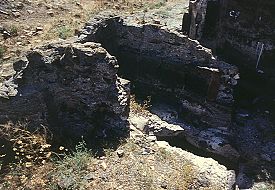 9. Graves beside the church of Saint Gregory of the Abughamir's - desecrated by treasure hunters
|
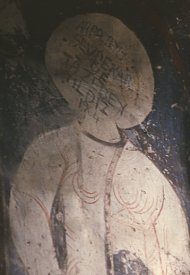 12. Got vandalism on your frescoes? |
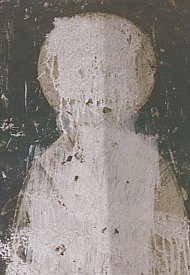 13. Then paint over it with whitewash |
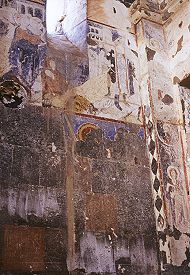 14. Or just chip the damaged bits off |
|
In 1965, 1966, and 1967 there were archaeological excavations at Ani undertaken by Professor Kemal Balkan. Two bathhouses were uncovered: Marr had previously excavated one of them, the other was a new discovery. These excavations seem to have been done to a reasonably high standard, the results were properly published, and some of the pottery artefacts discovered are still on display in the Kars archaeological museum.
Starting in 1991 new excavations began on various structures at Ani. These excavations are still continuing and until her death were under the direction of Professor Beyhan Karamağaralı (1934-2008) of Hacittepe University, Ankara. Critics have said that Karamağaralı had no understanding of Armenian art and architecture. She did not understand even the most basic techniques needed to undertake a modern archaeological excavation. She was very rarely on-site, and ws happy to allow her excavations to be left to the shovels and pickaxes of unskilled and unsupervised labourers. Materials that modern archaeologists would seek to carefully record and study are either destroyed during the excavation process or are simply discarded. In an age where the goal of archaeology is now "total recovery" Karamağaralı instead excelled at "zero recovery". Normal procedures to remove the archaeological spoil (the soil and debris that results from an excavation) are never followed by the Turkish excavators. The spoil is simply dumped elsewhere within Ani and is spread out over unexcavated areas, contaminating that ground for future proper archaeology. Finds are always interpreted in a simplistic and amateurish way: for example, if a fragment of pottery bearing Arabic lettering is found in abuilding, then that building is automatically assumed to have been inhabited by Muslims. Nikolai Marr wrote out against such "backward methodology" over 70 years ago ³. The Turkish excavators fail to properly consolidate or maintain any foundations they uncover - within a few years excavated buildings become just piles of rubble overgrown with vegetation. The excavators have an inordinate fondness for covering the tops of any walls they uncover with a thin layer of poor quality cement that quickly crumbles to dust. Karamağaralı published almost nothing about her excavations, and her survey drawings are so simplistic that they border on being useless. Even after over twelve years of excavations, not a single artefact found by Karamağaralı has ever been put on public display or catalogued - everything is locked away in a warehouse in Kars (to which only she had access to) and there are rumours of the widespread theft of artifacts. Anyway, most artifacts are not even removed by the archaeologists but are simply discarded to be lost, destroyed, or stolen. The truth is that the activities of Turkish "archaeologists" at Ani have little to do with proper archaeology. At best they consist mainly of clearing the debris and fallen masonry that has accumulated over a building in order to expose any surviving foundations. At worst it is simply cultural vandalism. It was unfortunate that French archaeologists and art historians from the Sorbonne were actively involved with Karamağaralı at Ani since 1998. They were headed by Professor Jean-Pierre Mahé. The French archaeologists are, in private, extremely contemptuous of all of Karamağaralı's work and they have intentionally worked separately from their Turkish partners. However, in public they said nothing to either improve or limit her activities at Ani. Neither did they publicly protested against the Turkish Ministry of Culture's restorations. Some of their representatives in Paris were actually engaged in silencing protests from fellow French academics about the state of affairs at Ani. Click here to see an example of this. Karamağaralı used the presence of these foreign archaeologists to add prestige to, and deflect criticism from, her own work at Ani. Funding from the Sorbonne also partly paid for her destructive excavations.
The construction of this fence inflicted considerable damage throughout Ani. Creating the concrete foundation involved cutting through and destroying many layers of archaeology. To reach the more remote corners of the site a road was bulldozed up the eastern side of the citadel, where no track had previously existed. Without any thought of the damage, for months heavy trucks, excavators, and tractors were allowed to repeatedly cross and re-cross the city at high speeds, crushing anything on the surface under their wheels and, by compacting the earth, damaging any fragile archaeological remains under the surface. The Turkish and French archaeologists use their large minibus to create the same effect.
After the construction of the fence, the local villagers were forbidden to graze their livestock within Ani. This has led to the ground become rapidly overgrown with vegetation. As well as making it impossible for visitors to walk to (or even see) many of the minor monuments, the extremely dense plant growth is now damaging the walls of many of the buildings.
...back to the previous page "The Rediscovery of the Ruins".
|
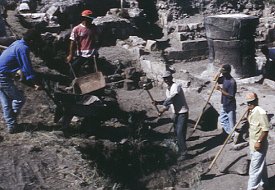 15. Labourers "excavating" the fire temple during 1999, while Karamağaralı was relaxing back in Ankara 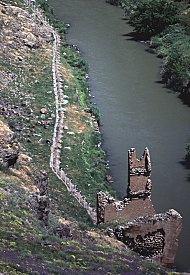 16. Part of the security fence that encircles Ani
|